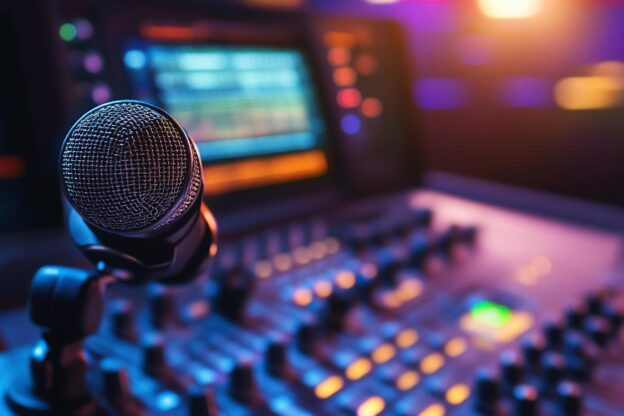Good morning and welcome to our live broadcast! It’s a crisp autumn morning here in the city, and the air is filled with the promise of a new day. We’ve got a packed news hour ahead, covering everything from the latest developments in the world of technology to the upcoming local elections. Speaking of technology, did you know that the new 5G network is rolling out across the country? This promises to be a game-changer for internet speeds and connectivity, but there are also concerns about potential health risks. We’ll be taking a look at both sides of the story later this hour.
Also, we’ll be hearing from a local entrepreneur who’s using his passion for radio to connect with the community. Remember the days of sitting around the radio, listening to the stories and music that would fill your imagination? Well, he’s bringing that back, but with a modern twist. We’ll be talking about his new online radio station, which is attracting listeners from all over the world. So, stay tuned for a lively and informative hour of news and conversation.

Radio News Broadcast Live
1. Radio News Broadcast Live
Welcome back to our live radio broadcast! We’re bringing you the latest news, weather, and traffic updates, so you can stay informed and connected. This morning, we’re diving deep into the ongoing debate surrounding the new infrastructure bill, exploring its potential benefits and concerns. Our expert panel will discuss the bill’s impact on various sectors, including transportation, energy, and technology. We’ll also check in with our reporters across the country for local perspectives on this significant legislation.
In other news, the global stock market experienced a surge this week, driven by strong economic indicators and positive investor sentiment. We’ll analyze the factors contributing to this rally and assess its potential long-term implications. Additionally, we’ll provide updates on the ongoing wildfire season, highlighting the latest containment efforts and urging listeners to stay safe. So, stay tuned as we bring you the news that matters most.
2. Realtime reporting of current events
Imagine being able to hear about breaking news as it happens! That’s the power of real-time reporting, a crucial element of radio news broadcasts. Reporters work tirelessly to gather information, verify facts, and deliver updates to listeners as events unfold. This dynamic form of journalism keeps you connected to the pulse of the world, providing insights into major stories, local developments, and global happenings, all in an engaging and informative way.
Real-time reporting goes beyond simply conveying facts. It allows radio news to offer analysis, context, and expert perspectives on evolving situations. You can hear the voices of those affected, understand the potential implications of events, and gain a deeper understanding of the world around you. This immediacy and depth make radio news a vital source of information and a powerful tool for staying informed and engaged.
3. Delivered by news anchors and reporters
Radio news broadcasts come alive with the voices of news anchors and reporters. These skilled individuals bring the news to life by delivering information in a clear and engaging manner. They use their voices to convey the gravity of events, the excitement of breakthroughs, and the human stories behind the headlines. Anchors guide listeners through the news, providing context and analysis, while reporters bring us firsthand accounts from the scene of the story.
News anchors and reporters build trust with their audience by presenting information accurately and objectively. They strive to be impartial, offering a balanced perspective on complex issues. Their dedication to delivering reliable news keeps listeners informed and engaged, fostering a sense of community and shared understanding.
4. Often includes interviews and soundbites
Radio news broadcasts often feature interviews with experts, eyewitnesses, and other relevant individuals. These interviews provide valuable insights and firsthand accounts of the news stories. They give the audience a deeper understanding of the events and perspectives on the issues. For example, during a report on a local election, a news anchor might interview a political analyst to get their expert opinion on the results.
In addition to interviews, radio news broadcasts commonly use soundbites. These are short audio clips of people talking about the news story, whether it’s a politician making a statement, a citizen expressing their opinion, or a sound effect that helps create a sense of the story’s atmosphere. Soundbites add variety and immediacy to the broadcast, making it more engaging for listeners.
5. Focus on local national and international news
Staying informed about what’s happening in your community, your country, and around the world is essential. Local news keeps you updated on important events in your neighborhood, such as school board meetings, city council decisions, and local crime reports. National news provides insights into major events impacting the entire country, like political developments, economic trends, and social movements. And international news broadens your perspective, allowing you to understand global issues, conflicts, and cultural events that shape our interconnected world.
By focusing on all three levels of news, you gain a well-rounded understanding of the world. You can connect local events to broader national and international trends, and see how global issues affect your community. This comprehensive approach helps you become a more engaged citizen, capable of making informed decisions and participating in meaningful conversations.
6. Typically broadcast on AMFM radio stations
Radio news broadcasts are a staple of AM and FM radio stations, bringing listeners up-to-date on current events. These broadcasts often feature a blend of local and national news, covering everything from politics and weather to sports and entertainment. Radio news anchors deliver the information in a clear and concise manner, providing listeners with the essential details they need to stay informed.
In addition to news reports, radio stations often include interviews with experts and eyewitnesses, adding depth and perspective to the stories. They may also feature live reports from the scene of breaking news events, providing listeners with firsthand accounts of what’s happening. Radio news broadcasts are a vital source of information for many people, especially those who rely on audio formats for news consumption.
Conclusions
So, there you have it! Radio news is a vibrant and essential part of our daily lives. It delivers the latest news, whether it’s happening down the street or across the globe, straight to your ears. You’ll hear the voices of seasoned news anchors and reporters, alongside interviews and soundbites that bring the stories to life. Whether you’re tuning in to your local station or catching international updates, radio news offers a quick and engaging way to stay informed.
Remember, radio news is more than just a source of information. It’s a way to connect with your community and understand the world around you. So next time you hear that familiar radio jingle, give it a listen and see what’s happening in your neighborhood and beyond!


















